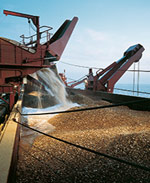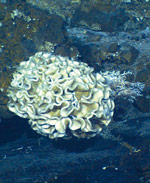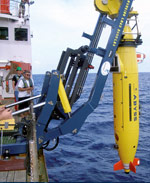- Sea-floor mining
- > Diamonds, gravel and sand have been extracted from coastal waters for decades. To meet the growing demand for metals, there are plans to mine the ores found in the form of manganese nodules, cobalt crusts and massive sulphides at depths of up to 4000 metres. If and when such sea-floor mining is to start will depend on metal prices on global markets. Working in deep water is still uneconomic, and no appropriate mining equipment is available yet.

Ocean mining – not a gold rush but an option
For decades people have been extracting mineral resources from the sea, including diamonds off Namibia or sand from the coastal areas of Europe for filling depleted beaches. In Europe alone around 93 million tonnes of sand are extracted from the sea each year – a quantity which equals the volume of 37 Cheops Pyramids. Governments and industrial corporations plan to produce even more from the sea in the coming decades. Specifically, they aim to extract hundreds of millions of tonnes of metal-bearing minerals that are found on the sea floor in 3 forms: firstly, as potato-sized manganese nodules; secondly, as hard coatings on the flanks of undersea volcanoes called cobalt crusts; and thirdly, as massive deposits that have formed at hot, mineral-rich deep-sea vents known as massive sulphides. These resources are of interest because they contain large amounts of economically interesting metals, some of which greatly exceed the known amounts in deposits on land. The manganese nodules in the Pacific manganese nodule area of the Clarion-Clipperton Zone alone contain around 5 billion tonnes of manganese, which is some 10 times as much as the economically minable deposits on land today. Many of the marine metal occurrences have been known since the 1970s. Even then manganese nodules were excavated from the Pacific in pilot projects. For a long time mining of the sea floor remained unattractive because there were enough resources on land and metal prices were relatively low. But in the past decade, mainly due to growing demand in the newly industrializing countries, especially in China, prices have risen strongly. Marine mining is interesting for various reasons. For one, demand for chemical elements contained in the marine deposits is rising because of new high-tech applications such as smartphones. For another, many of these elements are only mined in a few countries. China, in particular, has a dominant market position. Many states would therefore like to secure their own claims on the sea floor. It is problematic that many hundreds of square kilometres of seabed will be negatively impacted by ocean mining. Marine biologists are concerned that mining will destroy deep-sea habitats. To prevent a gold rush in the ocean, the International Seabed Authority (ISA) was established in Jamaica in 1994. It awards licence areas in international waters to interested states and ensures that developing countries will also be able to share in the benefits. In addition, the Authority has negotiated regulations for the protection of deep-sea environments. Licence areas cannot be completely mined out. Some areas have to remain untouched so that they can contribute to the recolonization of the mined areas. To what extent, or whether at all the mining of the sea will develop is still uncertain. No mining equipment suited to the task is available yet, and some metal prices, after an interlude of extreme increases, have dropped again, so that deep-sea mining now appears less economical. However, some 200-nautical-mile zones, where the ISA is not responsible, are still thought to be promising. Within these zones the coastal states decide for themselves when and under what environmental and safety standards metals are extracted. Of particular interest are the 200-nautical-mile zone of Papua New Guinea, where massive sulphides with high gold and silver contents are found, and the Cook Islands, where cobalt-rich manganese nodules are located. Mining of the precious-metal-bearing deposits in Papua New Guinea appears to be economical today. An industrial consortium wants to begin mining there by the end of 2016.



